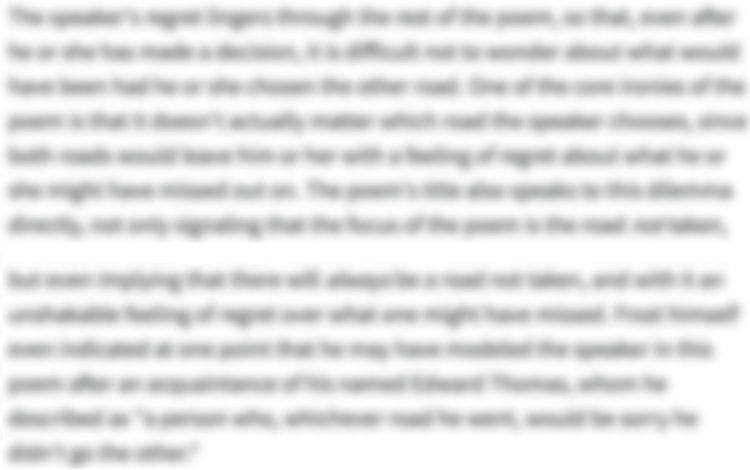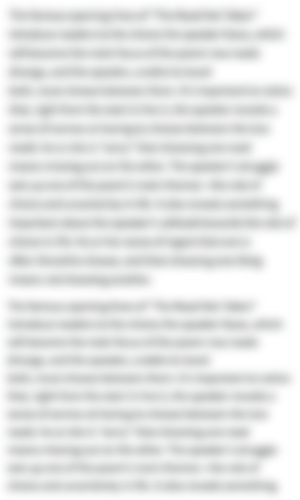The Full Text of “On the Sea”
1It keeps eternal whisperings around
2Desolate shores,—and with its mighty swell
3Gluts twice ten thousand caverns,—till the spell
4Of Hecate leaves them their old shadowy sound.
5Often ’tis in such gentle temper found,
6That scarcely will the very smallest shell
7Be lightly moved, from where it sometime fell,
8When last the winds of heaven were unbound.
9Ye, that have your eye-balls vex'd and tired,
10Feast them upon the wideness of the Sea;—
11Or are your hearts disturb'd with uproar rude,
12Or fed too much with cloying melody,—
13Sit ye near some old cavern’s mouth, and brood
14Until ye start, as if the sea-nymphs quired.
-
“On the Sea” Introduction
-
John Keats wrote "On the Sea" while he was taking a holiday on the Isle of Wight in 1817. His friend John Reynolds submitted it to a London newspaper, The Champion, on his behalf; the paper published the poem later that year. In this sonnet, a speaker advises that people who are worn out and irritated by the "uproar" of daily life should go and sit quietly beside the ocean for a while. The sea's vastness, mystery, and power, the speaker suggests, can refresh even the noisiest mind—and open people up to a wider world of imagination.
-
-
“On the Sea” Summary
-
The sea whispers perpetually against lonely, faraway sands, and its powerful tides overflow thousands of caves, until the power of the moon goddess Hecate draws the tide back out and leaves those caves dark and quiet again. It's often in such a mild mood that it will hardly move even the teensiest seashell from the spot it landed the last time a storm blew through.
If you've irritated and exhausted your eyes, go and feed them with the sea's vastness. Or, if you've unsettled yourself with all the stupid noise of daily life, or overindulged in sickly-sweet music—then, go sit just inside a sea-cave, and lose yourself in thought, until you startle back to consciousness as if you'd heard the song of ocean spirits.
-
-
“On the Sea” Themes
-

The Mystery and Beauty of the Ocean
To the speaker of “On the Sea,” the ocean’s grandeur is an antidote to all the meaningless noise and nonsense of everyday life. With its strange rhythms, its vastness, and its myths, the ocean offers an alternative to the tiresome, petty “uproar” that people live in most of the time. Paying quiet attention to something so big and mysterious, the speaker suggests, offers people a strange kind of healing. To this speaker, the ocean helps people put life into perspective, helping them escape the constant noise of their own thoughts and troubles.
In this speaker’s eyes, the ocean offers people a point of contact with eternity, mystery, and magic. Its “eternal whisperings” touch the shores of faraway lands that people have never visited, its vastness can fill “twice ten thousand caverns,” and its endless soft sounds suggest the singing of nymphs. At once “mighty” and “gentle,” the ocean is one great big mystery: a place that encourages people to open their minds both to the wide unknown and to tiny things they might often overlook, like the “very smallest shell” that lands at their feet.
That kind of mind-opening mystery, the speaker goes on, is the perfect antidote to the pointless chaos that bedevils most lives. The speaker encourages anyone who has strained their eyes, ears, and hearts with the “uproar” of the day-to-day to simply go and sit beside the sea until they’re deeply lost in thought. In fact, the speaker encourages people to go so deep into their reveries that they “start” (or jump) as they come back to themselves. Merely coming near the mysteries of the ocean, the speaker suggests, is enough to expand, calm, and quiet the human mind—and to give people a little respite from the noise of their own thoughts.
- See where this theme is active in the poem.
-
-
Line-by-Line Explanation & Analysis of “On the Sea”
-
Lines 1-2
It keeps eternal whisperings around
Desolate shores,"On the Sea" begins mysteriously. Without the title there to guide them, readers might not even know that the speaker is describing the sea: the speaker merely introduces an enigmatic "it" that whispers around the "shores" of lonely, faraway lands.
The personification here suggests that this "it" could be a spirit, or even an immortal god: its "whisperings" are "eternal," and it can travel to "desolate" places that no human foot has ever touched.
In other words: this poem sees the ocean as more than just a bunch of water. To this speaker, the sea is a conscious, living force. And it seems to have a message to communicate. Those "eternal whisperings" might contain secret wisdom.
The speaker wants readers to hear the ocean's whisper for themselves. Listen to the strong sibilance of these first words:
It keeps eternal whisperings around
Desolate shores,Those repeated /s/ sounds—along with the consonant /sh/ and /z/ sounds—are onomatopoeic, sounding just like what they're describing: the steady, quiet hiss of ocean waves.
Right from the start, then, this poem immerses readers in the physical experience of being by the ocean and listening to the surf. But it also invites readers to see this as more than just a physical experience. To hear the "whisperings" of the ocean, the speaker suggests, is to come into contact with some mysterious spirit of nature. The rest of this poem will explore this sea-spirit's personality and encourage readers to get to know it for themselves.
-
Lines 2-4
—and with its mighty swell
Gluts twice ten thousand caverns,—till the spell
Of Hecate leaves them their old shadowy sound.

Unlock all 354 words of this analysis of Lines 2-4 of “On the Sea,” and get the Line-by-Line Analysis for every poem we cover.
Plus so much more...
Get LitCharts A+ -
Lines 5-8
Often ’tis in such gentle temper found,
That scarcely will the very smallest shell
Be lightly moved, from where it sometime fell,
When last the winds of heaven were unbound. -
Lines 9-10
Ye, that have your eye-balls vex'd and tired,
Feast them upon the wideness of the Sea;— -
Lines 11-12
Or are your hearts disturb'd with uproar rude,
Or fed too much with cloying melody,— -
Lines 13-14
Sit ye near some old cavern’s mouth, and brood
Until ye start, as if the sea-nymphs quired.
-
-
“On the Sea” Symbols
-

The Sea
This poem is about the sea both literally and symbolically. In its symbolic role, the sea represents the mysterious depths of the imagination.
Encouraging people to get lost in thought beside the ocean, the speaker is also encouraging them to look beyond the chatter of their everyday minds and into the unknown. The vastness, strangeness, and magic of the sea here are all images of the scope and beauty of the irrational, dreaming parts of the mind. Sitting by this kind of "sea" is not only enchanting, but inspiring: an encounter with the imagination like the one the speaker describes here must have produced this very poem.
- See where this symbol appears in the poem.
-
-
“On the Sea” Poetic Devices & Figurative Language
-
Consonance
The consonance in "On the Sea" helps evoke the sounds and moods of the ocean. Sibilance, in particular, turns up all through the poem, forming a backdrop of /s/ sounds that suggests the "eternal whisperings" of the sea itself. (Read more about the poem's dramatic sibilance under Onomatopoeia.)
But other forms of consonance also help to evoke the ocean's behavior. Take a look at the /t/ and /l/ sounds in this passage:
Often ’tis in such gentle temper found,
That scarcely will the very smallest shell
Be lightly moved, from where it sometime fell,These soft, light, tip-of-the-tongue sounds evoke both the fragile delicacy of that "very smallest shell" and the ocean's strange, intermittent "gentleness."
- See where this poetic device appears in the poem.
-
Assonance


Unlock all 97 words of this analysis of Assonance in “On the Sea,” and get the poetic device analyses for every poem we cover.
Plus so much more...
Get LitCharts A+ -
Apostrophe
-
Caesura
-
Enjambment
-
Personification
-
Onomatopoeia
-
Allusion
-
-
“On the Sea” Vocabulary
Select any word below to get its definition in the context of the poem. The words are listed in the order in which they appear in the poem.
- Desolate
- Swell
- Gluts
- Hecate
- Temper
- Scarcely
- Sometime
- Unbound
- Ye
- Vex'd
- Rude
- Cloying
- Brood
- Quired
Desolate-
Remote, lonely, or distant.
- See where this vocabulary word appears in the poem.
-
Form, Meter, & Rhyme Scheme of “On the Sea”
-
Form
"On the Sea" is a Petrarchan sonnet. This means that it's built from two parts: an octave (or eight-line passage) that explores a theme, and a sestet (or six-line passage) that introduces a new idea. The beginning of the sestet is called the "volta" (or "turn"), and it marks a transition from one kind of thinking to another.
Here, the volta begins with apostrophe: the speaker turns from a mysterious, meditative portrait of the sea to an invitation, encouraging anyone who feels worn out by life to come and lose themselves in the sea's mysteries.
The poem's shape thus reflects its bigger philosophy. Switching from meditative description to broad apostrophe, the speaker seems to say that everyone (not just poets) can be refreshed and restored through an encounter with the grandeur of the sea—and, symbolically, an encounter with the depths of the imagination.
-
Meter
As a sonnet, "On the Sea" uses iambic pentameter. This means that every line uses five iambs, metrical feet with a da-DUM rhythm, like this:
Or are | your hearts | disturb'd | with up- | roar rude,
But the speaker doesn't keep strictly to this meter through the whole poem. Instead, the speaker often plays with stresses, switching them around to mirror the descriptions. For instance, take a look at what happens when the speaker uses apostrophe in lines 8 and 9:
Ye, | that have | your eye- | balls vex'd | and tired,
Feast them | upon | the wide- | ness of | the Sea;—Here, the speaker starts by dropping a syllable altogether, leaving the stressed word "Ye" to stand alone. Something similar happens in the next line, when the speaker begins with a trochee (a stressed-unstressed, DUM-da foot). Putting strong stresses right up front, the speaker introduces the poem's sestet (or last six lines) with a flourish, emphatically inviting everyone into an encounter with the sea's mysteries. These metrical variations also keep the language fresh and engaging, pulling readers from line to line with a pleasing kind of musicality.
-
Rhyme Scheme
Since "On the Sea" is a Petrarchan sonnet, it uses a standard rhyme scheme in the first eight lines (or octave). It then follows one of several different traditional patterns in the last six lines (or sestet). The rhyme scheme looks like this overall:
ABBAABBACDEDEC
This pattern of rhyme shapes the speaker's thoughts. The ABBA section is descriptive, evoking the moods and movements of the ocean. Then, when the poem comes to its volta (or turning point) in line 9, the speaker addresses readers in a direct apostrophe, encouraging them to go soak up some of the sea's grandeur for themselves.
Keats might have chosen the Petrarchan sonnet form here precisely because its patterns of rhyme fit his subject. That back-and-forth ABBA is like the motion of waves, and the CDEDEC pattern—which returns to the same place it began after a more complicated journey—moves like the thoughts of the person who sits down to "brood" in a sea-cave, getting so deeply lost in thought that they have to suddenly "start" back to normal awareness.
-
-
“On the Sea” Speaker
-
Judging by their careful attention to the ocean, their impulse to escape the clamor of daily life, and their love of myth and legend, this poem's reflective speaker has a lot in common with Keats himself. But the poem doesn't clearly identify the speaker: anything readers learn about the speaker, they learn through the observations that the speaker makes about the surrounding world.
This all fits right into Keats's ideas about poetry. According to Keats, poets should be like chameleons, transforming themselves into the things they write about rather than imposing their own egos on the world. By disappearing into a description of the sea, then, the speaker gets lost in contemplation—exactly what the poem advises its readers to do.
-
-
“On the Sea” Setting
-
"On the Sea" is set, unsurprisingly, beside the sea. But the speaker isn't just describing a day at a particular beach. The sea that the speaker imagines is more like an archetypal sea: a place of mysterious and awesome power, full of mythic creatures, and with its own unpredictable moods and feelings. In other words: this encounter with the vast power of the real ocean also puts the speaker in touch with the symbolic ocean of the imagination.
-
-
Literary and Historical Context of “On the Sea”
Literary Context
John Keats wrote "On the Sea" on the Isle of Wight in April 1817, taking a much-needed holiday from his native London. He had published his first volume of poetry, Poems, just a month earlier. Keats's early reviewers were often condescending and dismissive, snobbishly writing Keats off as a common "Cockney" with no business dabbling in lyric poetry. But Keats's friends (including influential figures like the poet and journalist Leigh Hunt) believed in him deeply, and encouraged him to take a break, regroup, and keep on writing. This poem's sense of the sea as a restorative answer to the "uproar rude" of daily life reflects Keats's own troubles and hopes during this time.
Keats's thoughts on the sea in this poem were deeply influenced by a long tradition of poetic thought about the ocean. This poem owes a lot to Shakespeare, whose imaginative visions of the sea in King Lear and The Tempest were much on Keats's mind during this period. And many of Keats's English Romantic-era contemporaries also used the sea as a symbol of the imagination and the unknown, from Coleridge (in "The Rime of the Ancient Mariner") to Shelley (in his elegy for Keats, "Adonais").
Only four years after his holiday to the Isle of Wight, Keats would die at the age of 25—but not before he'd written some of the most beloved and influential poetry in English literature. Generations of later poets have counted him as an inspiration, from the Victorian Tennyson to the contemporary Alice Oswald.
Historical Context
Encouraging readers to escape to the sea, the poem draws on some very Romantic ideas about the restorative power of nature. The early 19th century was marked by a dramatic shift in old ways of life: the Industrial Revolution was getting into gear, and the British economy shifted from farming to factories, the countryside to the city. Keats was one of many artists and thinkers at this time who sought relief from the growing noise, smoke, and bustle of the cities in the beauty of the natural world.
To the Romantics, nature wasn't just a nice place to have a picnic: it was a source of wisdom, spiritual beauty, and imaginative inspiration. To get lost in the loveliness of a flower or a bird's song, in their eyes, was a way to remember that there's more to the world than the mechanical and the scientific.
In this way, Romanticism rebelled against both earlier Enlightenment ideas of reason and order, and coming Victorian ideas about progress and propriety. Romanticism argued that the natural world wasn't there either to be dissected or mastered, but experienced.
-
More “On the Sea” Resources
-
External Resources
-
The Poem's Inspiration — Read about the circumstances in which Keats wrote this poem. He was probably inspired not just by his holiday on the Isle of Wight but by his reading (and rereading) of King Lear.
-
The Poem Aloud — Listen to the poem read aloud to the sound of waves.
-
The Romantic Sea — Read about how Keats's poem fits into a bigger Romantic interest in the ocean.
-
Keats, Shakespeare, and Mozart — Read about how Keats's love of Shakespeare and Mozart influenced this poem.
-
Keats's Life and Work — Learn more about Keats and his poetry at the British Library's website.
-
-
LitCharts on Other Poems by John Keats
-








